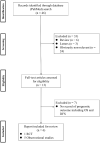Circulating Tumor Cells and the Non-Touch Isolation Technique in Surgery for Non-Small-Cell Lung Cancer
- PMID: 35326603
- PMCID: PMC8946695
- DOI: 10.3390/cancers14061448
Circulating Tumor Cells and the Non-Touch Isolation Technique in Surgery for Non-Small-Cell Lung Cancer
Abstract
Circulating tumor cells (CTCs) are dislodged from the primary tumor into the bloodstream, travel within the bloodstream to distant organs, and finally extravasate and proliferate as epithelial metastatic deposits. The relationship between the existence of CTCs and tumor prognosis has been demonstrated by many researchers. In surgery for malignancies, the surgical manipulation of tumors and tissues around the tumor may lead to the release of CTCs into the bloodstream. The non-touch isolation technique (NTIT) has been advocated to prevent the release of CTCs during surgery. The concept of NTIT is the prevention of intraoperative increment of CTCs from the primary tumor by the early blockade of outflow vessels, and 'pulmonary vein (PV)-first lobectomy' during surgery for non-small-cell lung cancer (NSCLC) corresponds to this technique. The concept of PV-first lobectomy is well known among thoracic surgeons, but evidence of its efficacy for preventing the increase of intra- and postoperative CTCs and for improving postoperative prognosis is still uncertain. Our study summarizes evidence regarding the relationship between NTIT and CTCs in NSCLC and suggests the need for further research on CTCs and CTC-detecting modalities.
Keywords: PV first lobectomy; circulating tumor cell; non-small-cell lung cancer; non-touch isolation technique; surgery.
Conflict of interest statement
The authors declare no conflict of interest.
Figures
Similar articles
-
Wedge Resection of Tumor Before Lobectomy for Lung Cancer Could Be a No-touch Isolation Technique.In Vivo. 2020 Mar-Apr;34(2):779-785. doi: 10.21873/invivo.11838. In Vivo. 2020. PMID: 32111784 Free PMC article.
-
Can the prognosis of colorectal cancer be improved by surgery?World J Gastrointest Surg. 2016 Aug 27;8(8):574-7. doi: 10.4240/wjgs.v8.i8.574. World J Gastrointest Surg. 2016. PMID: 27648161 Free PMC article. Review.
-
Circulating Tumor Cells from Surgical Manipulation Predict Recurrence and Poor Prognosis in Non-Small Cell Lung Cancer.J Clin Med. 2025 Mar 18;14(6):2070. doi: 10.3390/jcm14062070. J Clin Med. 2025. PMID: 40142879 Free PMC article.
-
Circulating tumor cells in the pulmonary vein increase significantly after lobectomy: A prospective observational study.Thorac Cancer. 2019 Feb;10(2):163-169. doi: 10.1111/1759-7714.12925. Epub 2018 Dec 4. Thorac Cancer. 2019. PMID: 30511800 Free PMC article.
-
Nanostructure embedded microchips for detection, isolation, and characterization of circulating tumor cells.Acc Chem Res. 2014 Oct 21;47(10):2941-50. doi: 10.1021/ar5001617. Epub 2014 Aug 11. Acc Chem Res. 2014. PMID: 25111636 Free PMC article. Review.
Cited by
-
Beyond the brain: exploring the impact of animal models of leptomeningeal disease from solid tumors.Acta Neuropathol Commun. 2025 May 19;13(1):103. doi: 10.1186/s40478-025-01959-4. Acta Neuropathol Commun. 2025. PMID: 40383789 Free PMC article. Review.
-
An international multicentre randomised controlled trial of en bloc resection of bladder tumour vs conventional transurethral resection of bladder tumour: first results of the en bloc resection of urothelium carcinoma of the bladder (EBRUC) II trial.BJU Int. 2025 Mar;135(3):446-455. doi: 10.1111/bju.16543. Epub 2024 Oct 27. BJU Int. 2025. PMID: 39462182 Free PMC article. Clinical Trial.
-
Applications of single-cell analysis in immunotherapy for lung cancer: Current progress, new challenges and expectations.J Adv Res. 2025 Aug;74:269-281. doi: 10.1016/j.jare.2024.10.008. Epub 2024 Oct 12. J Adv Res. 2025. PMID: 39401694 Free PMC article. Review.
-
Circulating Tumor Cells: From the Laboratory to the Cancer Clinic; A Closing Comment.Cancers (Basel). 2023 Feb 2;15(3):939. doi: 10.3390/cancers15030939. Cancers (Basel). 2023. PMID: 36765896 Free PMC article.
References
-
- Lee D.H., Tsao M.S., Kambartel K.O., Isobe H., Huang M.S., Barrios C.H., Khattak A., de Marinis F., Kothari S., Arunachalam A., et al. Molecular Testing and Treatment Patterns for Patients with Advanced Non-Small Cell Lung Cancer: PIvOTAL Observational Study. PLoS ONE. 2018;13:e0202865. doi: 10.1371/journal.pone.0202865. - DOI - PMC - PubMed
-
- Ashworth T.R. A Case of Cancer in Which Cells Similar to Those in the Tumors Were Seen in the Blood After Death. Aust. Med. J. 1869;14:146–147.
-
- Colombo C., Rolfo F., Maggi G. Further Research on the Isolation of Tumor Cells from Circulating Blood. Minerva Med. 1959;50:2217–2223. - PubMed
-
- Wilson J.K. The Detection of Tumor Cells in Circulating Blood. Bull. Tulane Univ. Med. Fac. 1959;18:171–182. - PubMed
-
- Romsdahl M.M., Potter J.F., Malmgren R.A., Chu E.W., Brindley C.O., Smith R.R. A Clinical Study of Circulating Tumor Cells in Malignant Melanoma. Surg. Gynecol. Obstet. 1960;111:675–681. - PubMed
Publication types
LinkOut - more resources
Full Text Sources


